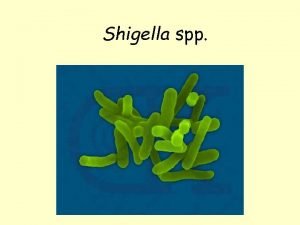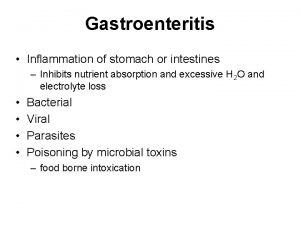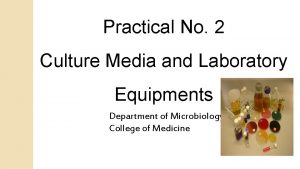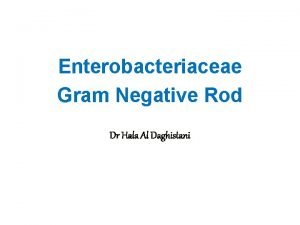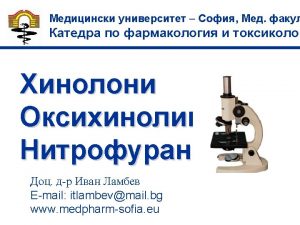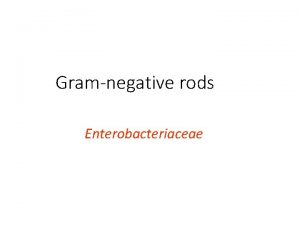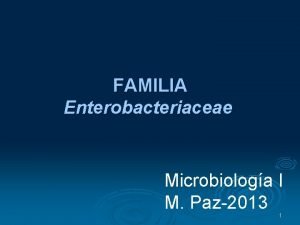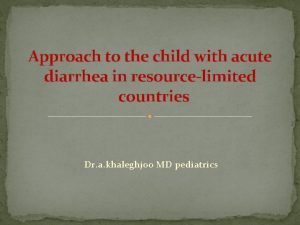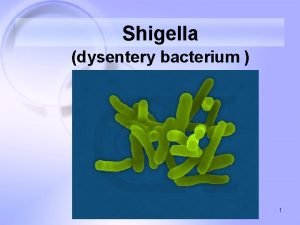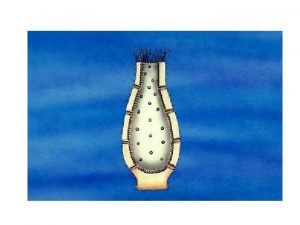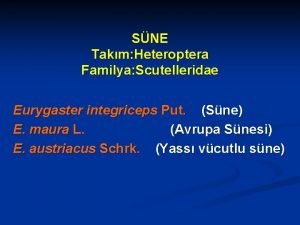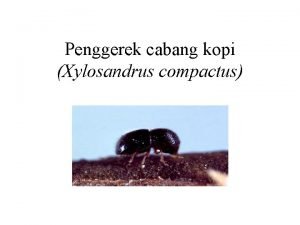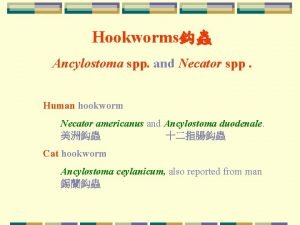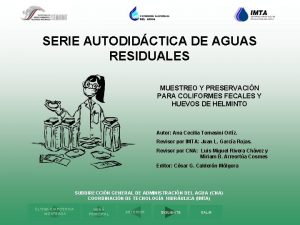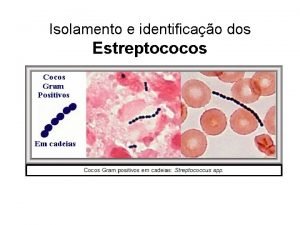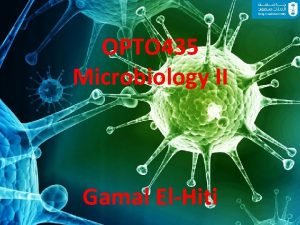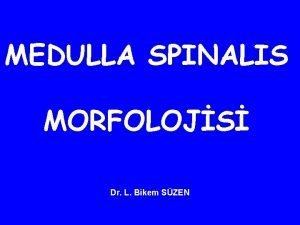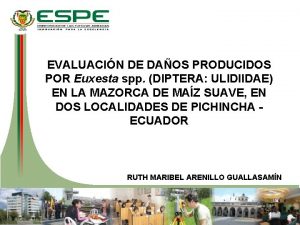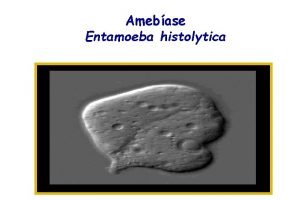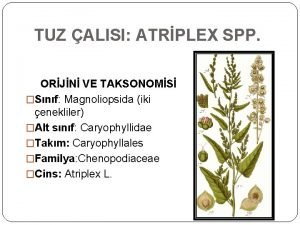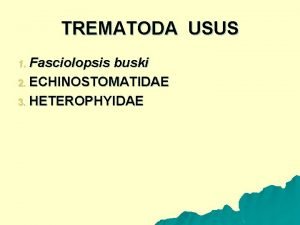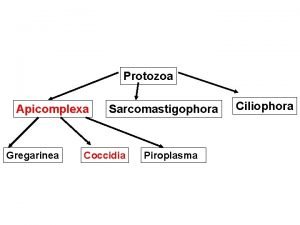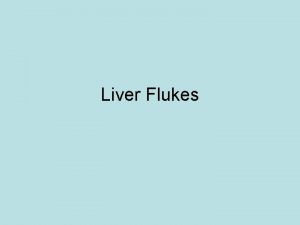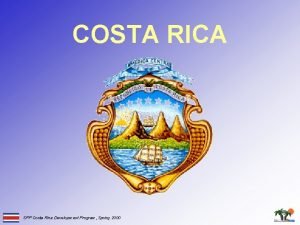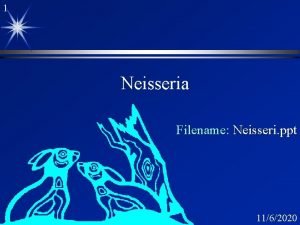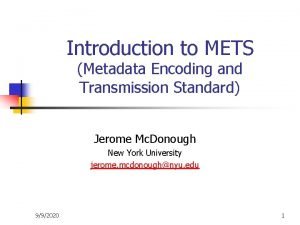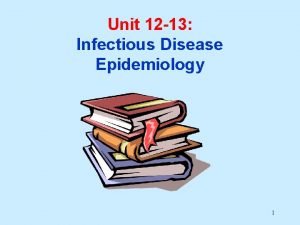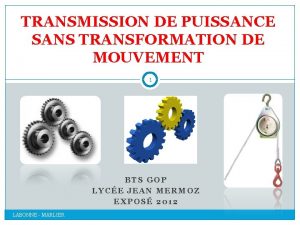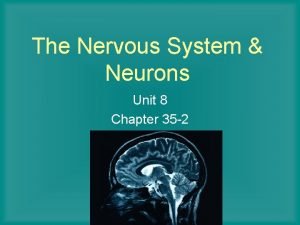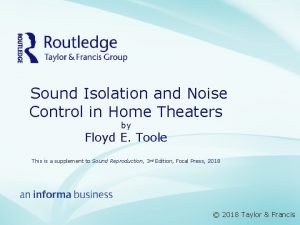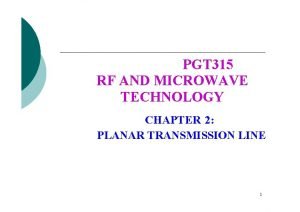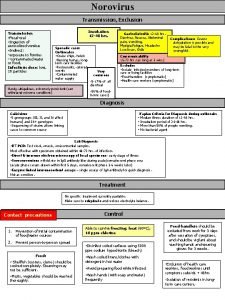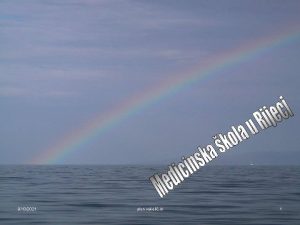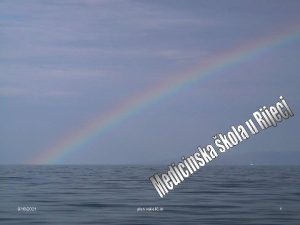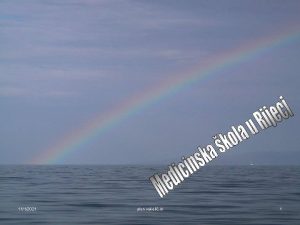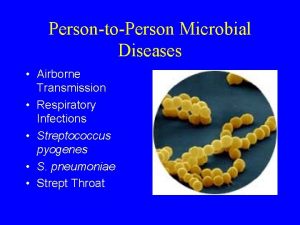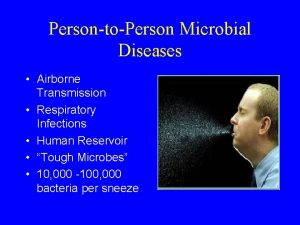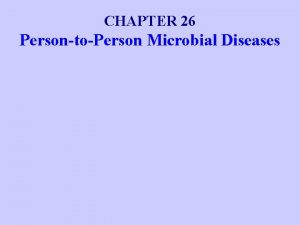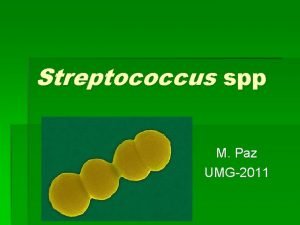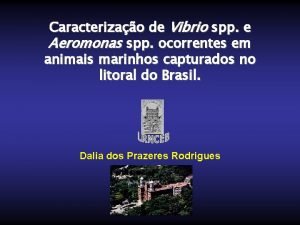Shigella spp Shigella and Shigellosis Fecaloral transmission persontoperson








































































































- Slides: 104

Shigella spp.

Shigella and Shigellosis • Fecal-oral transmission – person-to-person, fomites, food, water, ect. • Waterborne and water-washed • Reservoirs: humans and primates • Infectious dose: low; as few as 10 cells to infect • Incubation period: 1 to 7 days; typically, 1 -3 days • Duration of illness: – untreated: severe symptoms for about two weeks

Shigellosis - Illness • Persistent diarrhea with frequent and painful passage of stools consisting mostly of blood, mucus and pus – accompanied by fever and stomach cramps. • Blood and mucus in stools are likely signs of shigellosis • Shigella infect, invade cells lining the large intestine (colon) • Cause breaks (ulcers) in mucous membrane lining of intestine – Inflammation and tissue damage – Causes painful straining to pass stools; can lead to rectal prolapse – Ulcers commonly in the rectum – results in increased production of mucus

Shigellosis - Epidemiology • Four species of Shigella: flexneri, sonnei, dysenteriae, boydii • Major public health problem in many developing countries – causes about 5 to I 0% of childhood diarrhoea – up to 25% of all diarrhea-related deaths can be associated with Shigella Developing countries: • Sh. flexneri is endemic (always present) in most communities • Sh. dysenteriae type 1 often occurs in an epidemic pattern – organism can be absent for a number of years, then reappear and infect a large proportion of the population. • These two species of Shigella generally produce the most severe illness.

Salmonella and Salmonellosis • Belong to Enterobacteriaceae family • Gram-negative bacilli; facultative and flagellated (motile). • 3 major antigens: – "H" or flagellar antigen (phase 1 & 2) – "O" or somatic antigen (part of the LPS moiety) – "Vi" or capsular antigen (called "K" in other Enterobacteriaceae). • Posess LPS endotoxin characteristic of Gramnegative bacteria – composed of an "O” polysaccharide ("O" antigen) – "R" core – endotoxic inner "Lipid A". – Endotoxins evoke fever and can activate

Salmonella spp.

Salmonella gastroenteritis: (S. enteriditis): localized infection • Fecal‑oral transmission • Localized infection of intestines • Damage and inflammation to lamina propria • 0. 5‑ 2 day incubation period • Watery diarrhea, nausea, vomiting, abdominal cramps, low grade fever, lasting several days • Bacteria shed fecally at billions per gram • Infectious dose is relatively high: >103 ID 50 for many strains

Salmonella enteritidis

Typhoid fever: (S. typhi and S. paratyphi): Systemic Infection • Fecal-oral transmission • Systemic infection: – Macrophages, reticuloendothelial system (esp. liver, spleen and bone marrow), gallbladder and intestines as major sites of damage • 1. 5‑ 2 week incubation period • Symptoms: fever, headache, malaise, anorexia, then bloody diarrhea • Mortality rate 10%, if untreated • Carrier state possible – "Typhoid Mary”: infamous food handler; infected hundreds • Fecally shed at billions/gram by ill persons and

Salmonella typhi

Yersinia pestis • Gram Stain: – Small, gram-negative bipolar-stained coccobacilli • Wayson Stain: – Pink-blue cells with a closed safety pin look

Yersinia pestis: Plague • U. S. averages 13 cases/yr (10 in 1998) • 30% of cases are in Native Americans in the Southwest. 15% case fatality rate • Most cases occur in summer

Plague Epidemiology • Three Clinical Types: – bubonic (infected lymph nodes) – septicemic (blood-borne organisms) – pneumonic (transmissible by aerosol; deadliest)

Legionella spp. • • Gram-negative Aerobic Non-sporing Encapsulated ~46 species, 68 serogroups Ubiquitous aquatic organism Thrives in warm environments (32 C-45 C)

Legionella: Legionellosis and Pontiac Fever Reservoirs and amplifiers: • Hot water systems • circulating water ventilation systems (cooling towers) • Plumbing (e. g. , shower heads). • Hot tubs, whirlpools, etc. • Produce fresheners Cleveland Auto plant outbreak, March, 2001: • Plant cooling tower is considered a possible source of the outbreak. • But, more than 100 other internal water sources -favorite breeding grounds for the Legionella bacteria -- were also under investigation….

Legionnaire’s Disease and Pontiac Fever Legionnaire's disease: • Bacterial pneumonia caused by Legionella pneumophila. • A type of pneumonia that affects the lungs and may also affect the stomach and intestines, kidneys, and central nervous system. • Incubation period: 2 -10 days after exposure • Frequently requires hospitalization • Aerosol exposure from contaminated cooling towers, evaporative condensers, whirlpools, shower heads, faucets, & hot water tanks. Pontiac fever: also caused by Legionella. • A "flu-like" illness with fever, chills, headache, myalgia (pain in the muscles), cough, nausea, and breathlessness. • Pneumonia does not occur.


Fungal Pathogens John Scott Meschke Office: Suite 249 N, 4225 Roosevelt Phone: 206 -221 -5470 Email: jmeschke@u. washington. edu

Kingdom Fungi • Major role in recycling of organic matter”Saprophytes” or “Saprobes” • Eukaryotic, unicellular or multicellular structures with rigid chitinous cell wall • No chlorophyll • Asexual and sexual reproduction – Anamorph or Telomorph – Homothallic or heterothallic

FUNGI - Yeasts, Molds, Fleshy fungi Yeasts: spherical to oval cells reproduce by budding aerobic to anaerobic Dimorphic fungi: pathogens yeast in the animal; fungus in the environment

Fungal structure yeasts – single-celled organisms cell wall – chitin typical eukaryotic cell molds – hypha (hyphae) – long thin filaments aggregated hyphae form the mycelium cell wall of chitin

Fungal Structures • Hyphae • Spores • Conidia (asexual spores)




Medically Relevant Fungi • Three major divisions: – Ascomycota (ascospores) – Basidiomycota (basidiospores) – Zygomycota (zygospores) • Fungi Imperfecti – Deuteromycota

Ascomycetes – sac fungi red, brown and blue-green fungi associated with food spoilage plant diseases chestnut blight and Dutch elm disease edible morels and truffles examples: Morchella esculenta common morel Claviceps purpurea – parasite of rye and other grasses disease called ergotism in humans – poisoning in humans St. Anthony’s fire – killed thousands in Middle Ages psychotic delusions, nervous spasms, convulsions ergot alkaloids – LSD

Basidiomycetes – club fungi smuts, rusts, shelf fungi, puffballs, toadstools, mushrooms basidium – club-shaped structure on which spores are produced basidiocarp – mushroom most are saprophytes

Basidiomycetes – club fungi smuts, rusts, shelf fungi, puffballs, toadstools, mushrooms basidium – club-shaped structure on which spores are produced basidiocarp – mushroom most are saprophytes

Basidiomycetes – club fungi examples: smuts & rusts – crop damage in millions Agicarium campestris – multimillion-dollar business Amanita phalloides – toxic two toxins – phalloidin and α-amanitin phalloidin – liver toxin α-amanitin – lining of the intestinal tract Cryptococcus neoformans – cryptococcosis lungs and central nervous system

Zygomycetes most soil organisms a few pathogens of plants, insects, animals form thick-walled zygospores sexual reproduction – fusion of + and - strains examples: bread mold Rhizopus; black spores Mucor – production of sofu from soybeans some pathogens

Deuteromycetes – fungi imperfecti no sexual stage most saprophytes, a few parasites of plants examples: Penicillium – production of antibiotics Aspergillus – production of soy sauce also produce aflatoxins

Yeasts oval, single-celled organisms used in fermentation bread, wine, beer examples: Saccharomyces cerevesiae

Fungal Disease • Infection (mycosis) • Allergy • Hypersensitivity Pneumonitis (HP) and Organic Dust Toxic Syndrome (ODST) • Toxicosis • VOCs? ? ?


Fungal Infections • Mycosis: any fungal Infection • Systemic mycoses: fungal infection deep inside body. Can result from inhalation of spores. Ex: Valley fever (coccidioidomycosis) • Subcutaneous mycoses: infection beneath skin as a result of puncture

Fungal Infections, cont. • Cutaneous mycoses: infections of epidermis, hair, and nails. Direct contact with infected person, animal, hair, or cells is required. • Superficial mycoses: infections of hair shaft and surface (dead) epidermal cells

MEDICALLY IMPORTANT FUNGI Mycosis - fungal infection chronic infection Classification - mode of entry & tissue involvement Systemic - spores inhaled, begins as lung infection Subcutaneous - puncture wound Cutaneous - dermatomycosis epidermis, hair, nails tinea capitis, tinea cruris, tinea pedis Superficial - hair shaft or in epidermal cells Opportunistic - compromised host

MEDICALLY IMPORTANT FUNGI Cutaneous - dermatomycosis epidermis, hair, nails tinea capitis, tinea cruris, tinea pedis Superficial - hair shaft or in epidermal cells

MEDICALLY IMPORTANT FUNGI Opportunistic - compromised host Mucormycosis Aspergillosis enters through respiratory tract

MEDICALLY IMPORTANT FUNGI Opportunistic - compromised host Candidiasis – vaginal infections 10% of blood infections in hospital infections thrush – oral infection



Fungal Toxins • Most fungal toxins produced by: – Aspergillus spp. – Penicillium spp. – Fusarium spp. – Alternaria spp. – Rhizopus – Mucor


Important Mycotoxins • • • Aflatoxins Fumonisins Ochratoxins Trichothicenes Zearalenone and Zearalenoles • Tenuazonic • Patulin • Xanthomegnin and Viomellein • Nephrotoxic glycopeptides • Sterigmatocystin • Fusarochromanone • Ergot alkaloids • Citrinin • 3 -Nitropropionic acid • Roquefortine C • Secalonic acid D • Verrucosidin

Dermatophytosis (Ringworm and Tinea) Ringworm of scalp, glabrous skin, and nails caused by a closely related group of fungi known as dermatophytes which have the ability to utilize keratin as a nutrient source. The disease process in dermatophytosis is unique for two reasons: (a) No living tissue is invaded; the keratinised stratum corneum is simply colonized. However, the presence of the fungus and its metabolic products usually induces an allergic and inflammatory eczematous response in the host. The type and severity of the host response is often related to the species and strain of dermatophyte causing the infection. (b) The dermatophytes are the only fungi that have evolved a dependency on human or animal infection for the survival and dissemination of their species.

Tinea nigra. Tinea nigra is a superficial fungal infection of skin characterized by brown to black macules, which usually occur on the palmar aspects of hands and occasionally the plantar and other surfaces of the skin. Lesions are noninflammatory and non-scaling. Distribution: World-wide, but more common in tropical regions of Central and South America, Africa, South-East Asia and Australia. Aetiological Agent: Exophiala werneckii a common saprophytic fungus believed to occur in soil, compost, humus and on wood in humid tropical and sub-tropical regions. Familial spread of infection reported.

443

303

Malassezia infections. Pityriasis (tinea) versicolor: A chronic, superficial fungal disease of the skin characterized by well-demarcated white, pink, fawn, or brownish lesions, often coalescing, and covered with thin furfuraceous scales. The colour varies according to the normal pigmentation of the patient, exposure of the area to sunlight, and the severity of the disease. Lesions occur on the trunk, shoulders and arms, rarely on the neck and face, and fluoresce a pale greenish colour under Wood's ultra-violet light. Young adults are affected most often, but the disease may occur in childhood and old age. Distribution: World-wide but more common in tropical than temperate climates. Aetiological Agent: Malassezia furfur a lipophilic yeast forming part of the normal flora of human skin.

350

Histoplasmosis An intracellular mycotic infection of the reticuloendothelial system caused by the inhalation of the fungus. Approximately 95% of cases of histoplasmosis are inapparent, subclinical or benign. Five percent of the cases have chronic progressive lung disease, chronic cutaneous or systemic disease or an acute fulminating fatal systemic disease. All stages of this disease may mimic tuberculosis. Distribution: World-wide, especially U. S. A. Sporadic cases do occur in Australia. Aetiological Agent: Histoplasma capsulatum, especially from soil enriched with excreta from chicken, starlings and bats.

322

Coccidioidomycosis Initially, a respiratory infection, resulting from the inhalation of conidia, that typically resolves rapidly leaving the patient with a strong specific immunity to re -infection. However, in some individuals the disease may progress to a chronic pulmonary condition or as a systemic disease involving the meninges, bones, joints and subcutaneous and cutaneous tissues. Distribution: Endemic in south-western U. S. A. , northern Mexico and various centres in South America. Aetiological Agent: Coccidioides immitis, a soil inhabiting fungus.


106

Subcutaneous zygomycosis (Mucormycosis) Primary cutaneous and subcutaneous infections usually the result of a "barrier break" or traumatic implantation of fungal elements. Lesions vary considerably in morphology but include plaques, pustules, ulcerations, deep abscesses and ragged necrotic patches. Most heal with little treatment (debridement and amphotericin B) and they are not usually associated with dissemination. Distribution: World-wide. Aetiological Agents: Cosmopolitan members of the Mucorales including species of Rhizopus, Mucor, Rhizomucor, Absidia, Cunninghamella, Saksenaea and Mortierella.

472

Aspergillosis is a spectrum of diseases of humans and animals caused by members of the genus Aspergillus. These include (1) mycotoxicosis due to ingestion of contaminated foods; (2) allergy and sequelae to the presence of conidia or transient growth of the organism in body orifices; (3) colonization without extension in preformed cavities and debilitated tissues; (4) invasive, inflammatory, granulomatous, necrotizing disease of lungs, and other organs; and rarely (5) systemic and fatal disseminated disease. The type of disease and severity depends upon the physiologic state of the host and the species of Aspergillus involved. Distribution: World-wide. Aetiological Agents: Aspergillus fumigatus, A. flavus, A. niger, A. nidulans and A. terreus.

Cryptococcosis A chronic, subacute to acute pulmonary, systemic or meningitic disease, initiated by the inhalation of the fungus. Primary pulmonary infections have no diagnostic symptoms and are usually subclinical. On dissemination, the fungus usually shows a predilection for the central nervous system, however skin, bones and other visceral organs may also become involved. Distribution: World-wide. Aetiological Agent: Cryptococcus neoformans.

Candidiasis A primary or secondary mycotic infection caused by members of the genus Candida. The clinical manifestations may be acute, subacute or chronic to episodic. Involvement may be localized to the mouth, throat, skin, scalp, vagina, fingers, nails, bronchi, lungs, or the gastrointestinal tract, or become systemic as in septicaemia, endocarditis and meningitis. Distribution: World-wide. Aetiological Agents: Candida albicans, C. glabrata, C. tropicalis, C. krusei. C. parapsilosis, C. guilliermondii and C. pseudotropicalis. All are ubiquitous and occur naturally on humans.

05

065

069

Algae

Algae Divisions • Chlorophyta (green algae) – Least harmful, generally considered benefical – Growth in reservoirs; mild taste and odor; some filamentous mat formers • Cyanophyta (blue-green algae) – Prokayotes – Most significant concerns for water quality – Taste and odor problems; filter cloggers; oxygen depletion; toxicity

Algae Divisions • Chrysophyta (Yellow-Green/Golden. Brown Algae) – Taste and odor problems; reservoir growth; filter cloggers – Frustules used for filtration • Pyrrhophyta (dinoflagellates) – Taste and odor problems – Red tide problems

Algae Divisions • Euglenophyta (protozoan-like algae) – Indicators of pollution – Filter cloggers • Crytptophyta (crytomonads) – Taste and odor problems • Rhodophyta (red algae) – Growth on reservoir walls and irrigation ditches

Taste and Odor • Dirty or Musty – Geosmin and MIB (2 -methylisoborneol) – blue-green algae, actinomycetes • Fishy, Cod liver Oil – Chrysophyta, Pyrrhophyta • Septic Odor – Pryyhophyta • Cucumber Odor – Chrysophyta

Pyrrhophyta (Dinoflagellates) • unicellular – many have stiff, patterned plates • many photosynthetic – some ingest other cells • most are marine – some cause phosphorescence in ocean waters – some endosymbionts • zooxanthellae – unarmored form seen in host

thecae propels cell forward while causing it to spin Figure 26. 9 acts as rudder

Freshwater Algal Toxins • Anatoxin (e. g. Anabaena) – Staggering, paralysis, gasping, convulsions, death – 200 μg/kg LD 50 • Microcystin (e. g. Anabaena, Microcystis, Oscillatoria) – Jaundice, shock, abdominal pain/distention. Weakness, nausea, vomiting, severe thirst, rapid/weak pulse, death – 300 -600 μg/kg LD 50 • Saxitoxin/Neosaxitoxin (e. g. Anaphnizomenon) – Weakness, staggering, loss of muscle coordination, difficulty in swallowing, labored respiration, muscle paralysis, death, tingling around mouth or fingertips, slurred speech – 9 μg/kg LD 50 • Hepatotoxin (e. g. Gleotrichia) – Jaundice, abdominal pain/distention, weakness, nausea/vomiting • Cytotoxin (e. g. Gleotrichia) – Skin irritation, gastrointestinal upset

Marine Algal Toxins • PSP- Saxitoxins, Gonyautoxins, C-Toxins- Alexandrium (formerly Gonyaulax) spp. • ASP- Domoic Acid – Pseudonitchia spp. • DSP- Okadaic acid, dinophysiotoxins, pectenotoxins, and yessotoxin- Dinophysis spp. and Prorocentrum spp. • Ciguatera toxin, Maitotoxin, & Scaritoxin- Gambierdiscus toxicus • NSP/Brevetoxin- Karenia brevis (formerly Ptychodiscus or Gymnodinium breve) • Pfiesteria-like Toxins- Three putative toxins- lipid soluble dermonectrotic toxin, lipid-soluble lethality factor, watersoluble neurotoxin

Pfiesteria piscicida • Pfiesteria piscicida - colorless, singlecelled organism (dinoflagellate) • Capable of 24 distinct forms depending on water characteristics, major ones: – Amoeba forms – Zoospores – Gametes – Planozygote – Cyst forms

Pfiesteria and Fish • Toxic zoospores excrete toxins that drug fish and destroy skin • Gametes, zoospores and planozygotes feed on substances from sores on fish • Amoeba forms feed on dead fish • Toxins affect liver, brain, kidney and pancreas of fish • Toxins affect other aquatic life as well

Pfiesteria Toxins and Humans • Can affect humans by touching or ingesting water or breathing aerosolized water containing toxins • Respiratory problems • Headaches • Moodiness • Aching joints and muscles • Disorientation • Memory loss



























 Complications of shigellosis
Complications of shigellosis Shigellosis
Shigellosis Gastroenteritis
Gastroenteritis Define culture media
Define culture media Swarming proteus
Swarming proteus Nelidix
Nelidix Escherichia coli
Escherichia coli Bioquimica de shigella
Bioquimica de shigella Shigella
Shigella Shigella
Shigella Shigella bacteria characteristics
Shigella bacteria characteristics Shigella
Shigella Spp communication
Spp communication Schistosoma spp common name
Schistosoma spp common name Jadual kenaikan gaji tahunan
Jadual kenaikan gaji tahunan Trissolcus spp
Trissolcus spp Süne taksonomisi
Süne taksonomisi Sptweb
Sptweb Spp quante persone
Spp quante persone Pengurusi spp
Pengurusi spp Xylosandrus spp
Xylosandrus spp Necator spp
Necator spp Adiantum spp
Adiantum spp Red spp
Red spp Dipylidium spp.
Dipylidium spp. Streptococcus pyogenes meio de cultura
Streptococcus pyogenes meio de cultura Spp digital goods
Spp digital goods Spp itp
Spp itp Nerc regions
Nerc regions Life cycle of acanthamoeba
Life cycle of acanthamoeba M. spinalis
M. spinalis Leishmania spp
Leishmania spp El maiz
El maiz Morfologia
Morfologia Tos vuran böceği
Tos vuran böceği Spp.org
Spp.org Tuz çalısı
Tuz çalısı Echinostoma spp
Echinostoma spp Spp da chi è composto
Spp da chi è composto Spp.org
Spp.org Cryptosporidiosis
Cryptosporidiosis Opisthorchis felineus morphology
Opisthorchis felineus morphology Nilai teras unimas
Nilai teras unimas Andrew radcliff
Andrew radcliff Escherichia spp
Escherichia spp Spp org
Spp org Spp org
Spp org Pythium spp
Pythium spp Spp tcr calendar
Spp tcr calendar What is it
What is it Costa spp
Costa spp Neisseria spp ppt
Neisseria spp ppt Solar power satellites and microwave power transmission
Solar power satellites and microwave power transmission Motion transmission examples
Motion transmission examples Mets format
Mets format Chapter 19 disease transmission and infection prevention
Chapter 19 disease transmission and infection prevention Advantages and disadvantages of delta modulation
Advantages and disadvantages of delta modulation Radio frequency telemetry system block diagram
Radio frequency telemetry system block diagram Signal to noise ratio
Signal to noise ratio Baseband and broadband transmission
Baseband and broadband transmission Chapter 19 disease transmission and infection prevention
Chapter 19 disease transmission and infection prevention Reflection refraction absorption
Reflection refraction absorption Digital vs analog transmission
Digital vs analog transmission Analog and digital signals in computer networking
Analog and digital signals in computer networking Transmission terminology in data communication
Transmission terminology in data communication Digital data digital signals
Digital data digital signals Data transmission concepts
Data transmission concepts Chapter 19 disease transmission and infection prevention
Chapter 19 disease transmission and infection prevention Transmission basics and networking media
Transmission basics and networking media Enhanced mail
Enhanced mail Standard precautions and transmission-based precautions
Standard precautions and transmission-based precautions Advantages and disadvantages of wireless power transmission
Advantages and disadvantages of wireless power transmission 2 input nand gate using pass transistor logic
2 input nand gate using pass transistor logic What is parallel and serial transmission
What is parallel and serial transmission Wireless power transmission project report doc
Wireless power transmission project report doc Relational identity
Relational identity Factors that affect disease transmission
Factors that affect disease transmission Tableau macrocible
Tableau macrocible Guided media
Guided media Lossless transmission line problems
Lossless transmission line problems Transmission line examples
Transmission line examples Transmission de mouvement
Transmission de mouvement Transmission de puissance
Transmission de puissance Transmission de puissance
Transmission de puissance Transformation de mouvement par excentrique corrigé
Transformation de mouvement par excentrique corrigé Transmission bridge
Transmission bridge Transmission mechanism
Transmission mechanism Nerve impulse transmission steps
Nerve impulse transmission steps Support de transmission
Support de transmission Sound transmission loss
Sound transmission loss Sex limited traits example
Sex limited traits example Rangkaian ekivalen saluran transmisi
Rangkaian ekivalen saluran transmisi Sabal trail transmission
Sabal trail transmission Pneumatic power transmission
Pneumatic power transmission Social studies as citizenship transmission
Social studies as citizenship transmission Transmission medias
Transmission medias كبيل
كبيل Physical transmission media used for network cabling
Physical transmission media used for network cabling Microstrip transmission line
Microstrip transmission line Microstrip transmission line
Microstrip transmission line Schéma d'une chaine de transmission numérique
Schéma d'une chaine de transmission numérique Automatic transmission troubleshooting chart
Automatic transmission troubleshooting chart Hypopolarization
Hypopolarization Nerve impulse steps with pictures
Nerve impulse steps with pictures Types of motion transmission
Types of motion transmission

